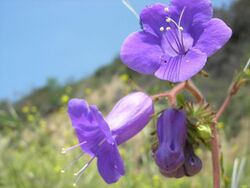Biology:Phacelia minor
| Phacelia minor | |
|---|---|

| |
| Scientific classification | |
| Kingdom: | Plantae |
| Clade: | Tracheophytes |
| Clade: | Angiosperms |
| Clade: | Eudicots |
| Clade: | Asterids |
| Order: | Boraginales |
| Family: | Boraginaceae |
| Genus: | Phacelia |
| Species: | P. minor
|
| Binomial name | |
| Phacelia minor (Harv.) Thell.
| |
| Synonyms[1] | |
|
List
| |
Phacelia minor, with the common names Whitlavia[2] and wild Canterbury bells,[3] is a species of phacelia. It is native to Southern California and Baja California, where it grows in the Colorado Desert and the coastal and inland mountains of the Transverse-Peninsular Ranges, often in chaparral and areas recently burned.
Description
Phacelia minor is an annual herb producing a mostly unbranched erect stem 20 to 60 centimeters tall. It is glandular and coated in stiff hairs. The leaves are up to 11 centimeters long with toothed, crinkly, oval or rounded blades borne on long petioles. The showy inflorescence is a one-sided curving or coiling cyme of many bell-shaped flowers, each up to 4 centimeters in length. The large flowers are lavender to deep blue-purple in color with protruding stamens tipped with white anthers.[4]
There are reports that glandular hairs of stems, flowers and leaves of P. minor secrete oil droplets that can cause an unpleasant skin rash (contact dermatitis) in some people.[5]
See also
- California chaparral and woodlands ecoregion
- California coastal sage and chaparral ecoregion
- Colorado Desert
References
- ↑ "Phacelia minor (Harv.) Thell.". Board of Trustees of the Royal Botanic Gardens, Kew. 2017. https://powo.science.kew.org/taxon/urn:lsid:ipni.org:names:191965-2.
- ↑ "Wildflower Search". https://wildflowersearch.org/search?oldstate=gloc:z;bloom:Ignore;name:Phacelia+minor.
- ↑ "Lady Bird Johnson Wildflower Center - The University of Texas at Austin". https://www.wildflower.org/plants/result.php?id_plant=PHMI.
- ↑ "California Bluebell, Phacelia minor". https://calscape.org/Phacelia-minor-().
- ↑ Reynolds, Gary; Epstein, William; Terry, Diane; Rodriguez, Eloy (1980). "A potent contact allergen of Phacelia (Hydrophyllaceae)". Contact Dermatitis 6 (4): 272–274. doi:10.1111/j.1600-0536.1980.tb04929.x. PMID 7398286.
Further reading
- Pink, A. (2004). Gardening for the Million. Project Gutenberg Literary Archive Foundation. https://www.gutenberg.org/ebooks/11892.
External links
Wikidata ☰ Q428718 entry
 |

